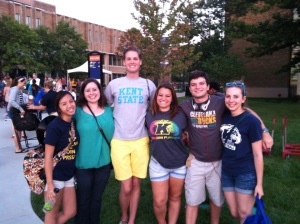 by Stephanie Smith
by Stephanie Smith
Often, public relations students will approach me—after hearing that I worked for the federal government for nearly 30 years—and say, “I’d really like to work for the federal government. How do I go about landing a job there?”
They’re often surprised when my response is a simple question: “What is it about government work that interests you?” If this question is met with blank stares, I usually follow up by asking: “What issues do you care about? What sort of public service are you passionate about?”
These questions can be conversation stoppers.
I’m still trying to figure out why, but it may be the case that for many students, the federal government looks sort of monolithic—if you work for the federal government, you work for the government. End of conversation.
In truth, working for the government in public affairs, including public engagement, public information and public advocacy, is highly differentiated. No two agencies of the government are the same; they differ by mission, by culture and by design. This means, of course, that the role of the public communicator will differ depending on where one works within the government. I spent nearly 30 years working in national security and intelligence; that’s quite a different mission and culture than working for the Department of Agriculture.
Explaining those differences, of course, is what high school civics classes are all about and not the purpose of this blog. Instead, I’ll focus on a few “essentials” for those who want to pursue a career in government public affairs, whether as a federal employee or as a contractor working for an agency that supports the government.
• Understand the role of government and the legislative process. Remember that old School House Rock cartoon, often rebroadcast by Jon Stewart, about how a bill becomes a law? It turns out that’s pretty important stuff. The government, at any level, works with issues, policy, laws and legislators. If you aren’t sure about how government works or about how the legislative process works, get familiar with it.
• Pick your passion—and do your homework. Are you interested in terrorism? Anti-bullying legislation? The environment? Food safety? Human trafficking? Healthcare reform? Or is your passion working for political campaigns, such as getting people elected or getting legislation passed?
One of the best ways to prepare for a public affairs job is to immerse yourself in an issue that plays to your passions. Study the issue deeply and understand who influences that issue. Which departments of government, which specific legislators and which specific lobbying groups and public interest groups focus on the issue? If you are interested in healthcare reform, for example, take some public health classes. Read all that you can. This information will be helpful with your job search strategy, on your résumé and in job interviews.
And by the way, it usually takes time to land a public affairs job inside the federal government. Start preparing now.
• Know the difference between public relations and public affairs. Yes, there are similarities. Both work with goals, strategies and objectives. Both use the tools and tactics of communication. Both seek to share information, promote understanding and persuade people. Both seek to build, manage and sustain relationships with stakeholder publics.
Public affairs, however, primarily handles issues, not commercial activity. In public affairs, you deal with causes, problems, public policy and laws. You build real grassroots coalitions and you deal with many types of stakeholders. (Think of the hundreds of stakeholder groups involved with healthcare reform.)
If you become a government employee, you will probably not be concerned with business development, client relations and billable hours. But you will be concerned with constituent relations, accountability reviews and congressional inquiries.
• Understand reputation management and crisis management. Let’s face it, the federal government isn’t popular. Most Americans see it as too big, too costly and too ineffective until they need it. If you work in government public affairs, you will be dealing with a “client” who is always controversial and frequently misunderstood, one whose reputation regularly takes a beating in the press. Sure, people complain when Starbucks® raises their prices, but they still line up for coffee (at absurd prices) and they don’t scream that Starbucks should be eliminated. When people get mad at the government, the issues are usually large, the stakes are high and tempers are hot. (Think about the whole debate over the healthcare.gov website.) You will always be explaining, defending and protecting your client’s reputation, you will regularly face crises of public confidence, you will always face vocal and passionate opponents and you will be expected to fix real problems—not to simply create cool viral videos or Pinterest postings.
Bottom line: If you like working for clients that are cool, fun, hip and beloved by their customers, government public affairs is probably not for you. But if you like working on big ideas, if you want to be part of big change and if you want to make a difference in people’s lives, government public affairs is an endlessly fascinating and meaningful career.






